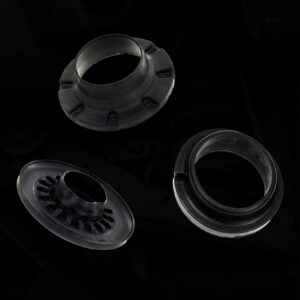Driving can become risky or uncomfortable when there’s something wrong with your car’s suspension system. If you’ve tried repairing any suspension issue, you’ll know that one part is seemingly connected to every piece: the coil spring.
Coil springs are notoriously difficult to replace, and it can be dangerous if the job is done incorrectly. Fortunately, there’s a tool that can make coil spring removal easier: the coil spring compressor.
What Is a Coil Spring Compressor?

A coil spring compressor is specifically designed to make it easier and safer to remove and install coil springs. Coil spring compressors have two main parts.
- A pair of clamps/hooks to grip onto the spring coils
- A rod or mechanism that applies pressure to compress the spring.
When you tighten the compressor, it squeezes the spring coils together, which reduces their length. This makes removal easier.
You can replace the springs without a coil spring compressor, but you risk damaging them and the parts around them. Without the tool, the spring tension can suddenly release and hit nearby components. It can also strike you and cause injuries.
Coil spring compressors work on any coil spring, straight or curved, and they’re built to last. They’re a must-have for DIYers. A high-quality coil spring compressor typically costs less than $50.
When Should I Use a Coil Spring Compressor?
A coil spring compressor makes it easier to replace coil springs, install shock absorbers or struts, And perform suspension repairs. These are only a few scenarios where a coil spring compressor can help you, but generally, you can use it for anything that involves coil springs.
Coil Spring Replacement
A coil spring compressor lets you safely remove old springs and install new ones. It also makes it easier to access and remove the suspension components under the spring tension if needed.
Shocks Absorbers or Struts Installation
It’s best to use a compressor when replacing struts, especially if you need to disassemble the spring. As mentioned, the springs can store significant amounts of potential energy when compressed, and getting hit when that’s released can hurt.
Car Suspension Jobs
Most suspension repairs and upgrades require removing the coil spring, making coil spring compressors an essential tool.
How to Use a Coil Spring Compressor
To use a coil spring compressor, follow the steps below:
- Step 1: Make sure you have the proper coil spring compressor. Pick one that works with the coil spring’s size, type, and tension.
- Step 2: Put on safety equipment, like gloves and goggles. Be sure you’re working on a flat surface and ensure you have enough space to do the job.
- Step 3: Use a jack to lift the part of the vehicle where the spring is. Support the car using jack stands to make it easier to remove the wheels and get access to the suspension components.
- Step 4: Find the affected coil spring. The coil spring is usually between the upper and lower suspension system’s control arms. If it’s not there, consult your owner’s manual for the exact location.
- Step 5: Place the compressor on the coil spring. Ensure it’s centered and secured. It’s better to position the spring on a bench or on the floor horizontally to ensure the pointed ends are facing away from your body.
- Step 6: The hooks or clamps should grip the coil firmly to prevent slippage. The compressors should be 180 degrees apart around the same position on each side of the coil spring.
- Step 7: Use a sock to tighten the compressor gradually and evenly. Alternate between sides to maintain equal pressure on the spring to ensure safety, as uneven pressure may cause the tool to slip.
- Step 8: Continue tightening the compressor until the spring is compressed. Once it is, check if it’s tightened and the spring isn’t slipping or shifting.
More Tips When Using a Coil Spring Compressor
Take care of the spring compressor. A worn or poorly maintained spring compressor can fail while you’re using it. Ensure the compressor stays in good condition by keeping its threads oiled. Check for cracks and rust before using it.
Another tip is to always check the compressor’s manual before using it. The instructions can vary depending on the tool. Some might even require additional tools (like an Allen key for shaft stability) for proper use.
The manual can also provide additional tips and proper usage, so it’s best to read it before tackling the suspension job.
Are Coil Spring Compressors Safe?
Yes, coil spring compressors are safe to use when handled properly. So be sure to read your compressor’s manual before using it.
Advantages of Coil Spring Compressors
Besides safety, coil spring compressors offer different advantages, including efficiency, precision, and versatility. These tools make the process of removing and installing coil springs quicker and easier compared to manual methods.
They also prove precise control over the compression process to ensure the spring is evenly compressed. Lastly, you can use a compressor for a handful of vehicles and suspension types, making them a versatile tool to own.
Any information provided on this Website is for informational purposes only and is not intended to replace consultation with a professional mechanic. The accuracy and timeliness of the information may change from the time of publication.





































